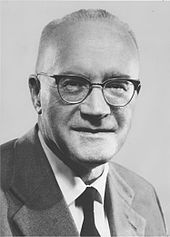Ludwig Bertele
Ludwig Bertele (born December 25, 1900 in Munich , † November 16, 1985 in Wildhaus SG ) was a German optics designer. From 1916 he was trained in calculating optical systems at Rodenstock . From 1919 he worked for the Dresdner Ernemann-Werke , which was merged into Zeiss Ikon in 1926 . From 1946 to 1956 he invented and calculated innovative aerial photography lenses for the Swiss company Wild Heerbrugg . In 1958, ETH Zurich awarded him an honorary doctorate for his achievements . From 1956 to 1973 he was a freelancer at Wild Heerbrugg AG.
Important photographic lenses developed by him in the lead include:
- Ernostar (1923)
- Sonnar (around 1930)
- Biogon (1935)
- Aerial lens Aviotar (1948)
- Super wide-angle biogon with 90 ° field of view (1951)
- Aviogon aerial photo lens with 90 ° field of view (1952)
- Aerial lens Super-Aviogon with 120 ° angle of view
Bertele's developments were groundbreaking for the optical industry at the time. The Biogon was conducted at Hasselblad cameras of NASA used the Gemini flights (1965-66) and the later Apollo missions to document (1968-1972).
In 1980 Bertele was awarded the Culture Prize of the German Society for Photography . In 1958 the ETH Zurich awarded Ludwig J. Bertele an honorary doctorate.
Web links
- Book tip: Ludwig J. Bertele - A pioneer of geometric optics on fotointern.ch
Individual evidence
- ^ Emil-Heinz Schmitz: Handbook on the history of optics: The step into the XX. Century. JP Wayenborgh, p. 499
- ↑ Ludwig Bertele: A new fast lens . In: Journal for Scientific Photography, Photophysics and Photochemistry , Vol. 24, 1926, pp. 31–36
- ^ Michael R. Peres: Focal encyclopedia of photography: digital imaging, theory and applications, history, and science. Focal Press, 2007
- ↑ Erhard Bertele: Ludwig J. Bertele. A pioneer in geometric optics. vdf Hochschulverlag AG at the ETH, Zurich 2017, ISBN 978-3-7281-3816-3 , p. 92
| personal data | |
|---|---|
| SURNAME | Bertele, Ludwig |
| BRIEF DESCRIPTION | German optics designer |
| DATE OF BIRTH | December 25, 1900 |
| PLACE OF BIRTH | Munich |
| DATE OF DEATH | November 16, 1985 |
| Place of death | Wildhaus SG |
